Canon TS-E50mm f/2.8L MACRO, TS-E90mm f/2.8L MACRO, TS-E135mm f/4L MACRO User Guide
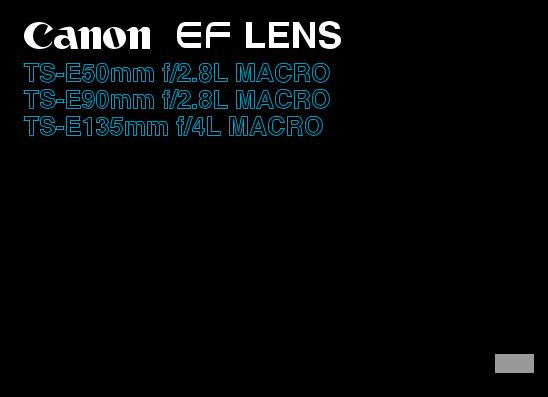
TS-E50mm f/2.8L MACRO
TS-E90mm f/2.8L MACRO
TS-E135mm f/4L MACRO
ENG
Instructions

Thank you for purchasing a Canon product.
The Canon TS-E50mm f/2.8L MACRO, Canon TS-E90mm f/2.8L MACRO, and Canon TS-E135mm f/4L MACRO are tilt-shift lenses* designed for EOS cameras that allow macro shooting up to 0.5 times magnification.
Camera Firmware
Please use the latest version of firmware with the camera in use. For details on whether the firmware is the latest version or not, and for details on updating the firmware, please check the Canon website.
Conventions used in this instruction
Warning to prevent lens or camera malfunction or damage.
Supplementary notes on using the lens and taking pictures.
* Depending on the camera model, the orientation or movement required for operation differs somewhat. For nomenclature and tilt operation, see the corresponding page for each model.
OOTS-E50mm f/2.8L MACRO Nomenclature: p.5, p.6 Using tilt: p.15, p.16
OOTS-E90mm f/2.8L MACRO, TS-E135mm f/4L MACRO Nomenclature: p.7, p.8
Using tilt: p.17, p.18
ENG-1

Safety Precautions
Precautions to ensure that the camera is used safely. Read these precautions thoroughly. Make sure all details are observed in order to prevent risks and injury to the user and other people.
 Warning Details pertaining to risks that may result in death or serious injury.
Warning Details pertaining to risks that may result in death or serious injury.
OODo not look at the sun or a bright light source through the lens or single-lens reflex camera. Doing so could result in loss of vision. Looking at the sun directly through the lens is especially hazardous.
OOWhether it is attached to the camera or not, do not leave the lens under the sun without the lens cap attached.
This is to prevent the lens from concentrating the sun’s rays, which could cause a fire.
 Caution Details pertaining to risks that may result in injury.
Caution Details pertaining to risks that may result in injury.
OODo not leave the camera in locations subject to high or low temperatures. This may result in the camera becoming excessively hot or cold, which may cause burns or other injuries when touched.
OO Do not insert your fingers inside the camera. Failure to observe this may result in injury.
OOBefore mounting or detaching the lens, or turning the lens for rotation or TS rotation, always lock the lens in a non-tilted and non-shifted position. Not doing so may cause injury.
OOWhen tilting or shifting the lens, avoid touching protrusions on the tilt mechanism and shift mechanism. Not doing so may cause injury.
Caution Details pertaining to risks that may result in damage to property.
OODo not leave the lens in excessive heat such as in a car in direct sunlight. High temperatures can cause the lens to malfunction.
OO Do not turn knobs forcefully. This may cause malfunction.
OOWhen mounting or detaching the lens or turning the lens for rotation, always lock the lens in a non-tilted and non-shifted position. Not doing so may cause malfunction.
ENG-2
This device complies with Part 15 of the FCC Rules. |
|
|
CAN ICES-3(B)/NMB-3(B) |
||
Operation is subject to the following two conditions: (1) This |
||
|
||
|
||
device may not cause harmful interference, and (2) this |
|
|
device must accept any interference received, including |
|
|
interference that may cause undesired operation. |
|
|
Do not make any changes or modifications to the equipment |
|
|
unless otherwise specified in the instructions. If such changes |
|
|
or modifications should be made, you could be required to |
|
|
stop operation of the equipment. |
|
|
This equipment has been tested and found to comply with |
|
|
the limits for a class B digital device, pursuant to part 15 |
|
|
of the FCC Rules. These limits are designed to provide |
|
|
reasonable protection against harmful interference in a |
|
|
residential installation. This equipment generates, uses and |
|
|
can radiate radio frequency energy and, if not installed and |
|
|
used in accordance with the instructions, may cause harmful |
|
|
interference to radio communications. |
|
|
However, there is no guarantee that interference will not |
|
|
occur in a particular installation. If this equipment does cause |
|
|
harmful interference to radio or television reception, which |
|
|
can be determined by turning the equipment off and on, the |
|
|
user is encouraged to try to correct the interference by one or |
|
|
more of the following measures: |
|
|
• Reorient or relocate the receiving antenna. |
|
|
• Increase the separation between the equipment and |
|
|
receiver. |
|
|
• Connect the equipment into an outlet on a circuit different |
|
|
from that to which the receiver is connected. |
|
|
• Consult the dealer or an experienced radio/TV technician |
|
|
for help. |
|
ENG-3

General Precautions
Handling Precautions
OO If the lens is taken from a cold environment into a warm one, condensation may develop on the lens surface and internal parts. To prevent condensation in this case, first put the lens into an airtight plastic bag before taking
it from a cold to warm environment. Then take out the lens after it has warmed gradually. Do the same when taking the lens from a warm environment into a cold one.
OO Please also read any lens related handling precautions listed in your camera’s instruction manual.
Shooting Precautions
OOTo ensure that you use the lens’ functions effectively, it is recommended that you shoot in the following conditions.
•Use an EOS camera with about 100% viewfinder visibility
•Use Live View (with onscreen grid)
•Use an external monitor
•Use a tripod
•Use a matte with grid focusing screen
•Use a stand-alone exposure meter
OOSince only a hood is not very effective in cutting off the harmful rays entering the lens, also using a piece of cardboard is recommended.
OOIf using Digital Photo Professional to perform lens correction (lens aberration correction, Digital Lens Optimizer, etc.)*, shooting with rotation or TS rotation locked or at a click position is recommended.
*Supported cameras: EOS 6D Mark II (As of August 2017)
ENG-4
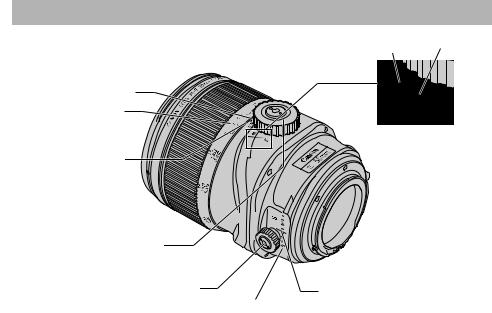
Nomenclature (TS-E50mm f/2.8L MACRO)
Tilt scale (→ 15) |
Tilt index (→ 15) |
|
Distance index |
Distance scale (→ 14, 28) |
Depth-of-Field scale (→ 28) |

 Lens mount index (→ 14)
Lens mount index (→ 14)
Tilt knob (→ 15)
 Contacts
Contacts
Shift knob (→ 19, 30) |
Shift index (→ 19) |
|
Shift scale (→ 19)
OOFor detailed information, reference page numbers are provided in parentheses (→ **).
ENG-5

Nomenclature (TS-E50mm f/2.8L MACRO)
Shift lock knob (→ 19) |
|
Rotation lock release |
Shift index (→ 19) |
button (→ 21) |
|
Shift scale (→ 19)
TS rotation lock release button (→ 23)
Lens
Filter mounting thread (→ 31)
Hood mount
Focusing ring (→ 14)
Tilt scale (→ 15)
Tilt index (→ 15)
Tilt lock knob (→ 15)
Tilt lock button (→ 15)
Illustration shows lens viewed from below.
OOFor detailed information, reference page numbers are provided in parentheses (→ **).
ENG-6
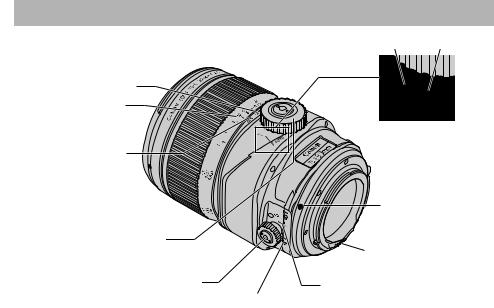
Nomenclature (TS-E90mm f/2.8L MACRO, TS-E135mm f/4L MACRO)
Tilt index (→ 17) |
Tilt scale (→ 17) |
Distance index
Distance scale (→ 14, 28)
Depth-of-Field scale (→ 28)
|
Lens mount index (→ 14) |
Tilt knob (→ 17) |
|
|
Contacts |
Shift knob (→ 19, 30) |
Shift index (→ 19) |
|
Shift scale (→ 19)
The illustration shows TS-E90mm f/2.8L MACRO, with nomenclature being the same for TS-E135mm f/4L MACRO.
OOFor detailed information, reference page numbers are provided in parentheses (→ **).
ENG-7
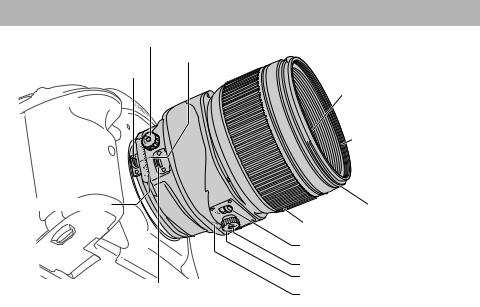
Nomenclature (TS-E90mm f/2.8L MACRO, TS-E135mm f/4L MACRO)
Shift lock knob (→ 19) |
|
Rotation lock release |
Shift index (→ 19) |
|
|
button (→ 21) |
|
Shift scale (→ 19)
TS rotation lock release button (→ 23)
Lens
Filter mounting thread (→ 31)
Hood mount
Focusing ring (→ 14)
Tilt lock button (→ 17)
Tilt lock knob (→ 17)
Tilt index (→ 17)
Tilt scale (→ 17)
Illustration shows lens viewed from below. The illustration shows TS-E90mm f/2.8L MACRO, with nomenclature being the same for TS-E135mm f/4L MACRO.
OOFor detailed information, reference page numbers are provided in parentheses (→ **).
ENG-8
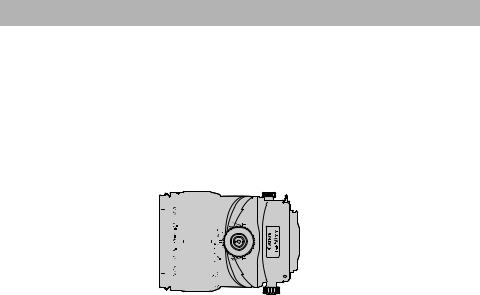
TS-E MACRO Lens Features
Canon TS-E50mm f/2.8L MACRO, Canon TS-E90mm f/2.8L MACRO, and Canon TS-E135mm f/4L MACRO have the following features.
OORange of tilt is ±8.5° for TS-E50mm f/2.8L MACRO, and ±10° for TS-E90mm f/2.8L MACRO and TS-E135mm f/4L MACRO.
OO Range of shift is ±12 mm.
OO Macro shooting at up to 0.5 times magnification when tilted or shifted is possible. OO Rotation allows the direction of the entire lens to be changed.
OO TS rotation allows the tilt operation angle to be changed in regard to shift. These features can be combined to allow a diverse range of expressive possibilities.
Tilt mechanism
|
|
|
|
|
|
|
|
|
|
|
|
|
|
|
|
|
|
|
|
|
|
|
|
|
|
|
|
Focus mechanism |
|
|
|
|
|
|
|
Shift mechanism |
|||||||||||||||||||
|
|
|
|
|
|
|
|
|
|
|
|
|
|
|
|
|
|
|
|
|
|
|
|
|
|
|
|
|
|
|
|
|
|
|
|
|
|
|
|
|
|
|
|
|
|
|
|
|
|
|
|
|
|
|
|
|
|
|
|
|
|
|
|
|
|
|
|
|
|
|
|
|
|
|
|
|
|
|
|
|
|
|
|
|
|
|
|
|
|
|
|
|
|
|
|
|
|
|
|
|
|
|
|
|
|
|
|
|
|
|
|
TS rotation mechanism Rotation mechanism
Illustration shows TS-E50mm f/2.8L MACRO.
ENG-9

TS-E MACRO Lens Features
 OOBefore mounting or detaching the lens, or turning the lens for rotation or TS rotation, always lock the lens in a non-tilted and non-shifted position.
OOBefore mounting or detaching the lens, or turning the lens for rotation or TS rotation, always lock the lens in a non-tilted and non-shifted position.
For how to lock the lens in a non-tilted and non-shifted position, see p.16, p.18, and p.20.
OOIf using Digital Photo Professional to perform lens correction (lens aberration correction, Digital Lens Optimizer, etc.)*, correction may not be performed adequately depending on the amount of tilt or shift, and on the rotation or TS rotation setting.
*Supported cameras: EOS 6D Mark II (As of August 2017)
ENG-10
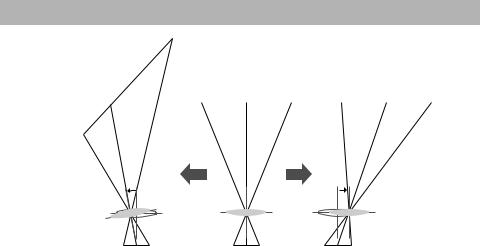
The Principle of Tilt and Shift
Focusing plane |
Focusing plane |
|
Focusing plane |
(after tilting) |
|
(after shifting) |
|
|
|
|
|
|
|
Optical |
|
Optical |
|
axis |
|
Tilt |
Shift |
||
axis |
|||
|
|
Imaging plane
OOBy tilting the lens, the lens’ optical axis is tilted with regard to the imaging plane, allowing the focusing plane to be tilted.
Imaging plane |
Imaging plane |
OOBy shifting the lens, the lens’ optical axis is moved in parallel with regard to the image plane, allowing the focusing plane to be moved in parallel.
ENG-11
